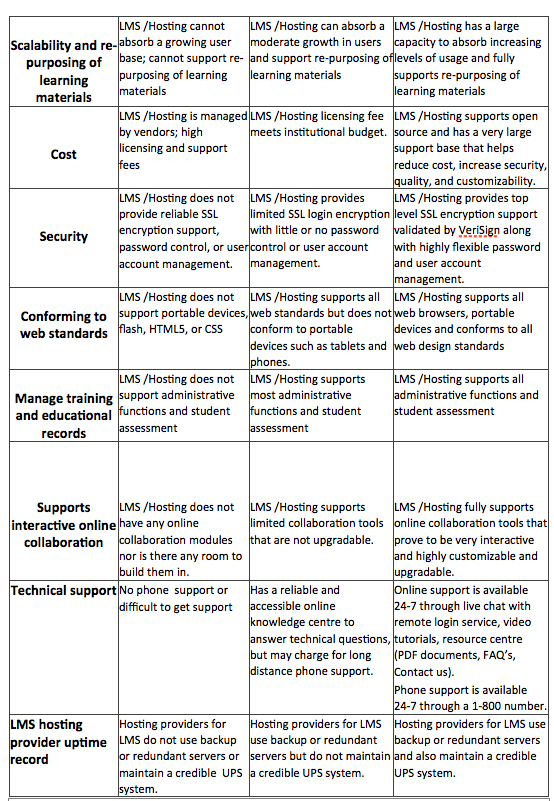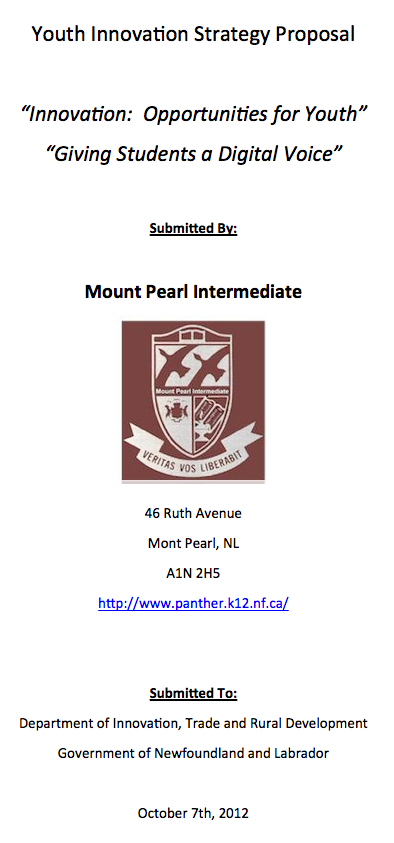LMS Proposal
Objective:
Mount Pearl Intermediate is proposing to design, develop, and implement a Learning Management System (LMS), which will run on a server (computer) running open-source software called Moodle. This server and software is online-based and will be used for the purpose of maintaining a series of classroom-based technology-related activities for our students taking place throughout the entire school year. This initiative will will focus on online blogging, video production, video streaming, online testing, social networking, and online desktop publishing in support of the Government of Newfoundland and Labrador’s Innovation Strategy, Innovation Newfoundland and Labrador: A Blueprint for Prosperity.
Project Description and Moodle LMS Background:
Diana and James L. Oblinger, editors of the book Educating The Net Generation, state that “..students spend so much of their time online…that they would have a strong preference for Web-based learning…”. Our Moodle LMS would only enforce this idea giving all stakeholders involved the opportunity to “..improve and enhance student performance by promoting and organizing communication among parents, students, teachers, administrators, and the community” (Perkins & Pfaffman, p.356). It is the intention of our school’s technology committee and the shared vision of our entire school to use a Moodle LMS for these purposes.
As one of the lead technology teachers at our school we are using the objectives listed above that were based on years of research and experience with the local server setup of Learning Management Systems. Our organization is committed to increasing student-teacher interaction and communication while at the same time focused on creating a space for parents, students, and teachers to connect in an online web-based virtual environment. The theme for this year’s initiative will be called ‘Innovation – Giving Students a Digital Voice”. That voice will come from the design, development, and implementation of a Learning Management System called Moodle running on a robust and reliable business class Linux server providing multi-location backup using unlimited bandwidth and storage.
So what exactly is Moodle and how can it be classified as an open-source Learning Management System (LMS)? This software program was intended for producing engaging, rich, interactive Internet-based courses. It’s core design was meant to enable organizations the opportunity to offer both structured and formal training mixed within an informal learning environment where knowledge sharing occurs via forum discussion, wikis design, social networking, video collaboration, and online testing. Perkins and Pfaffman, two important voices in this field state in their article Using a Course Management System To Improve Classroom Communication that “..web-based applications are a solution..” to institutions looking towards online learning and that “CMS’s enable teachers to easily post assignments, lesson plans, announcements, and course documents….allowing students to participate in online discussions and chats and turn in assignments online”.
Determining The Best Software For The Job:
With all that in mind, Moodle is also open-source in that it is free to acquire, install, configure, and edit/change. This is one main advantage it has over many other LMS’s such as Blackboard, WebCT, Jenzabar, and Desire-2-Learn in that there is no purchase cost and it maintains a very large community of knowledgeable people who are willing to assist when help is needed. Moodle can be used “to support our traditional classroom instruction and facilitate communication” (Perkins & Pfaffman, p.36). Moodle is easy to use, navigate and can be set up within 15 minutes of access (Perkins & Pfaffman p.37). Instead of worrying about purchasing costly annual site licenses, Moodle will allow us the opportunity to focus our attention on design and development of powerful rich online courseware. Please keep in mind that we did not come to decide on Moodle without much thought amongst our technology team.
Determining The Best Hardware For The Job:
Because Moodle is open-source and has no licensing cost involved the majority of our costs will be incurred from a reliable and scaleable, business class hosting service that will be able to handle the volume, bandwidth, and scaleability we will need. 1and1 hosting has been our first choice of hosting servers for this online venture. Other contenders such as GoDaddy, Hostgator, Bluehost, and Rackspace, were put to the test in our evaluation schemes below but fell short in a number of areas. Our hardware requirements were very specific due to the extensive testing we have been doing over the past couple of years while running a demo Moodle server in a virtual environment of VMware on one of our windows 2003 servers. Students, teachers, and parents had the opportunity to try out our beta virtual environment participating in Moodle virtual class discussions, submitting schoolwork, sharing ideas via live chat (audio/video) and working diligently on a Social Studies Wiki. This beta virtual environment was successful but very limited as we were plagued with bandwidth limitations, lack of SSL security, limited backups, and server speed. A generous contribution from your organization would fix all of our shortcomings.
Evaluating Our Choices:
As you can see below, our team has created an evaluation rubric to help guide the decision making process making it easier for you to understand why Moodle is the best software solution and 1and1 the hardware solution. Based upon our research, we would like to highlight the SECTIONS framework proposed by Bates and Poole (2003) when selecting an LMS as it also helped guide us towards our final software decision and therefore help solidify what hardware would be best suitable for the job. This framework, in addition to providing a detailed rubric should help facilitate your decision to provide the necessary funding for our online learning initiative. According to Bates and Poole the most viable LMS would be one that meets the following criteria:
– It has a cost structure that is affordable.
– It centralizes and automates administrative functions including all records and assessments
– It is easy to use for students for self-directed, self-paced learning
– It customizes and delivers learning materials rapidly
– It supports portability and follows e-learning web standards
– It maintains a high level of security and encryption for everyone using the system
– It provides multiple avenues of technical support
– It allows for flexible online collaboration
– It conforms to all recent web standard designs
– It provides accessibility to all users independent of their OS, browsers, or device type.
– It has to provide uptime using current UPS technology while maintaining reliable backups.
– at both the strategic and tactical level giving them the edge and balance between an affordable, safe, and customizable Learning Management System.
Our school will need to have faith in a system that is dependable, scalable, safe, secure, and affordable. It is the consensus of our group that if we follow the above guidelines and adhere to the criteria put forth in the rubric below that should help set the groundwork and provide the necessary answers you may have toward a final decision on potential funding.
Rubric Used For Both Hardware & Software:

After running all potential LMS’s through this rubric and Bates and Poole’s SECTIONS framework Moodle stands out on top of our list for software and 1and1 web hosting for our hardware.
Technical Training:
Even though Moodle’s open-source community can provide immeasurable assistance, we would be remiss if we did not ensure that we had teaching mentors in our school that had the opportunity to attend professional training for both server implementation and Moodle design and course development. This would also be part of our funding costs. We are looking at several online course training sites like Lynda.com, Moodlebites.com, and Lambdasolutions.net.
Timeline:
It is anticipated that if awarded INTRD funding then the pre-planning for server setup and online course development would begin immediately. The organizing committee would be established and then meet regularly beginning this month. All events related to the Moodle curriculum have already been pre-planned on our existing virtual server with a completion date when the funding for hosting is exhausted.
Financial Request:
Funding for this event is being requested from the Department of Innovation, Trade and Rural Development for the total amount of $20,000.00 (HST incl), $17700.00 pre HST.
In-Kind contributions would include the cost of using the facility (Mount Pearl Intermediate) and the management team of science and technology teachers who would make up the organizing committee for this event. The contribution of their time during the pre-planning and execution of this conference is all projected to occur outside of normal school hours and would therefore be in-kind totaling $18,000.00.
Total Projected Costs For Entire Proposal:
Hosting services $399.99/month for 12 months $4799.88
Includes a dedicated server containing an AMD Opteron 4274 processor (2 x 8 Cores x 2.5 GHz), 32 GB RAM, 3 x 1.5 TB SATA hard drives in RAID 5 array, Linux Ubuntu 12.04 OS, SSL certificate, external Cisco-based IP firewall, PHP5 with MySQL 5 database with unlimited bandwidth multiple UPS backup as well as off-site server mirroring.
Training (online) $5,000
Custodial Support and Teacher/Volunteer Involvement (In-Kind) $20,200.01
Class set of ultrabooks and Mobile charging cart $10,000
Total (**HST Included): $38,000.00
Budget Notes: HST is included in all budget costs indicated.
If awarded funding, our goals for this web-based virtual classroom would be:
- To create an alternative form of interaction between students and teachers
- To create a virtual environment that would help to inspire teacher and student learning
- To provide the groundwork for a future virtual school
- To provide awareness in the power of Learning Management Systems
- To give teachers and students the experience in web 2.0 design and development
- To give teachers and students alternative forms of testing
- To help improve classroom communication
- To educate the net generation
I would encourage our school district to adopt this new form of online learning passing on our knowledge and experience hoping that other schools will embrace it as a alternative form of learning.
References:
Bates, A.W. & Poole, G. (2003). Chapter 4: a Framework for Selecting and Using Technology. In Effective Teaching with Technology in Higher Education: Foundations for Success. (p. 77-105). San Francisco: Jossey Bass Publishers.
Chickering, A.W. & Gamson, Z.F. (1987). Seven Principles for Good Practice in Undergraduate Education. American Association for Higher Education Bulletin,39 (7), 3-7.
http://www.aahea.org/bulletins/articles/sevenprinciples1987.htm
Moodle. (2012). Retrieved October 4, 2012
From http://moodle.org/
Moodle. (2012). Retrieved October 2, 2012
From http://docs.moodle.org/23/en/About_Moodle_FAQ#Cost
Moodle. (2012). Retrieved October 4, 2012
Oblinger, Diana G. and Oblinger, James L. (2005) “Educating The Net Generation.” EDUCASE. Virginia Polytechnic Institute and State University, n.d. Web. 4 Oct 2012.
Perkins, M., Pfaffman, J. (2006). Using a Course Management System to Improve Classroom Communication. Science Teacher, 73(7), 33-37.



